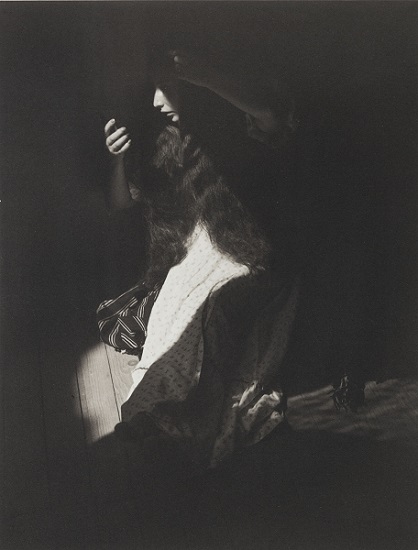
Manuel Álvarez Bravo
Mexican, 1902-2002
Portrait of the Eternal, 1935, printed 1981
platinum print, ed. 11/25
12 × 10 in.
SBMA, Gift of Joan Almond
2017.21.1.7

Undated Self-Portrait
"I think that light and shadow have exactly the same duality that exists between life and death." - Manuel Álvarez Bravo
COMMENTS
Lush contrasts of dark and light draw the viewer close to this timeless scene of a woman gazing into a mirror. Her eyes are obscured by a long shadow falling over her from forehead to hip. The shadow covers part of her wavy mane of hair, which she draws back with her left hand. She wears a flounced cotton gown, sprigged with a flower design, that has ruffles at her elbows; her ankles are crossed and her feet peek out below the hem of her dress. White triangles are formed by light falling onto parts of her body and her surroundings: on the fingers of her right hand holding the mirror; on the middle knuckle of her left hand; on her face from the edge of the long shadow to the tip of her nose and chin; onto her lap; and onto the folds of her dress and the wooden floorboards behind her, interrupted by some fringed threads extending from a rolled textile near the wall. Sensory cues abound, inviting the imagination to note the starkness and stillness of the room and to feel the texture of the hair, cloth, and floor. A quick look takes in an everyday scene of morning grooming rituals; further examination reveals that the image is a constructed metaphor for confrontation with time’s impacts on the body and the treachery of vanity, placing the photograph into the art historical tradition of symbolizing the brevity of life.
Considered the most renowned of Mexico’s photographers and one of its most important artists, Manuel Álvarez Bravo was twenty when he purchased his first camera and taught himself the art of photography. He had been introduced to the making of art by his father, a teacher and artist, and by his grandfather, a professional portrait painter. After his father died when he was thirteen he left school and went to work as a clerk at a textile factory and later at the Mexican Treasury Department while studying accounting at night. He eventually took classes in art at the Academy of San Carlos.
Born in 1902 while dictator Porfirio Diaz was still in power, Álvarez Bravo lived for one hundred years through the brutal violence of the Mexican Revolution and through the entire twentieth century. He participated in the artistic renaissance that flowered after the Mexican Revolution of 1910–20 by both embracing modernist emphases on art elements of form, light, and texture and by focusing his camera on typical Mexican landscapes and citizens. As a young man, he took a job at the magazine Mexican Folkways which led to his photographing and befriending the muralists Diego Rivera and José Clemente Orozco. As he began to exhibit his own photographs he became known for photographing mysterious juxtapositions in everyday scenes that bring awareness to the act of looking. Influenced by photographer Edward Weston’s emphasis on isolating form and creating abstractions from objects in the material world, as well as by André Breton and other Surrealist artists’ delight in finding unexpected and absurd relationships among objects, Bravo’s photographs often address a central theme of death and mortality in symbolic and metaphorical images of daily life.
KEY IDEAS
• Drawing attention to the experience of looking by depicting mystery in everyday objects and scenes
• Using light, shadow, and composition to highlight the camera’s ability to directly describe the material world
• Picturing moments of time within Mexican culture as emblems for timeless themes
DISCUSSION QUESTIONS
1. What compositional elements give life and energy to this scene? How does Manuel Álvarez Bravo use visual and spatial elements to create a sense of order and balance and a certain mood?
2. What clues in the photograph tell you something about this person? What seems to be happening? In what ways is this portrait different from an ordinary snapshot?
3. What is the source of the light? A lamp, a candle, sunlight, or something else? From what direction does it appear to be shining?
4. What ideas seem to be expressed by this image? In what ways could this image be described as a “visual parable?”
© Madison Museum of Contemporary Art. All rights reserved. 227 State Street, Madison, WI 53703
https://www.mmoca.org/learn/teachers/teaching-pages/manuel-alvarez-bravo
